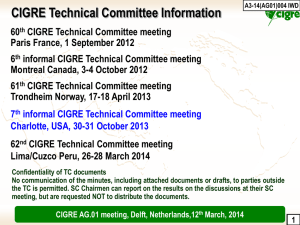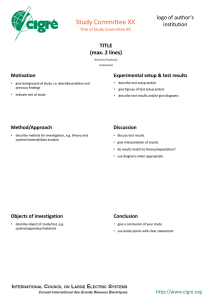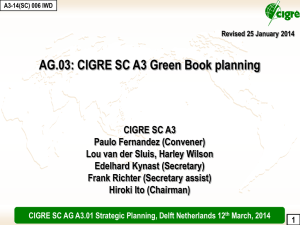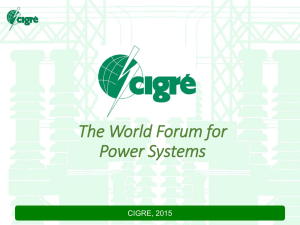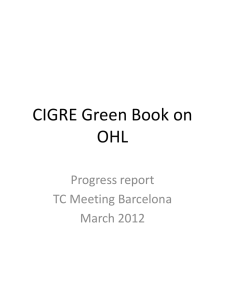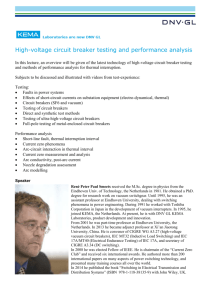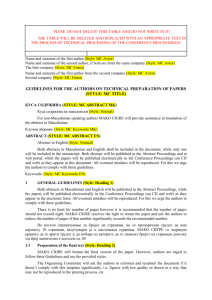A reference guide ( docx , 1 MB ) - UK
advertisement
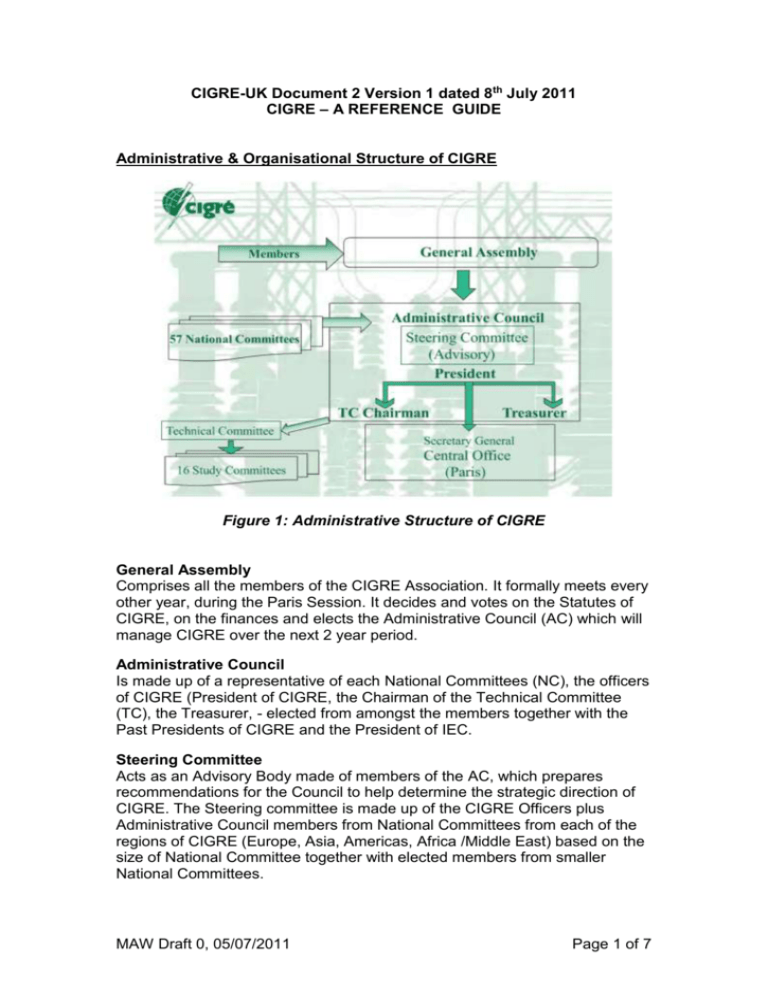
CIGRE-UK Document 2 Version 1 dated 8th July 2011 CIGRE – A REFERENCE GUIDE Administrative & Organisational Structure of CIGRE Figure 1: Administrative Structure of CIGRE General Assembly Comprises all the members of the CIGRE Association. It formally meets every other year, during the Paris Session. It decides and votes on the Statutes of CIGRE, on the finances and elects the Administrative Council (AC) which will manage CIGRE over the next 2 year period. Administrative Council Is made up of a representative of each National Committees (NC), the officers of CIGRE (President of CIGRE, the Chairman of the Technical Committee (TC), the Treasurer, - elected from amongst the members together with the Past Presidents of CIGRE and the President of IEC. Steering Committee Acts as an Advisory Body made of members of the AC, which prepares recommendations for the Council to help determine the strategic direction of CIGRE. The Steering committee is made up of the CIGRE Officers plus Administrative Council members from National Committees from each of the regions of CIGRE (Europe, Asia, Americas, Africa /Middle East) based on the size of National Committee together with elected members from smaller National Committees. MAW Draft 0, 05/07/2011 Page 1 of 7 Technical Committee Comprises the Chairman of the Technical Committee, all Study Committee Chairmen, 2 representatives of the Administrative Council and the Secretary General of CIGRE. It manages the technical activities of the CIGRE. Paris Session This is the main technical event of CIGRE which is held every two years in Paris with technical sessions reflecting each Study Committee, a large technical exhibition and numerous associated Working group and Study Committee meetings. Secretary General Manages the day to day activities of CIGRE together with the permanent staff based in the Central Office in Paris. National Committee Where countries have a minimum of 40 equivalent members they can set up a National Committee. National Committees act as a focus for the local members and promote the activities of CIGRE in their country. Neighbouring NCs can also set up a CIGRE Region, to address more efficiently "local" issues. Members Membership is available in several categories as follows; Collective members comprising Collective 1 and Collective 2 Consist of public or private companies, industrial and/or commercial activities, scientific organisations, research institutes and educational bodies. Collective 1 members are generally businesses whilst Collective 2 organisations are research institutes and educational organisations. Collective 1 membership entitles the organisation to have the equivalent of 5 standard members, Collective 2 membership entitles the organisation to have the equivalent of 2 standard members. Individual members Are individual engineers, scientists and other professionals engaged in all aspects of power engineering. Young members, aged under 35, pay reduced fees for their 2 first years of individual membership although other arrangements may be made locally e.g. those applicable to the NGN in the UK. Honorary Members Honorary membership is granted to those members who have provided exceptional service to CIGRE through technical or organisational contributions. Honorary members receive lifetime free membership and registration to the Paris Session. MAW Draft 0, 05/07/2011 Page 2 of 7 Distinguished Members Distinguished membership is granted to those members who have provided valued service to CIGRE through technical or organisational contributions. Distinguished members do not receive any additional benefits other than personal recognition. Colloquium This technical conference is organised by one or more Study Committees in the intervening (odd) years between Paris sessions. Colloquia are organised at the invitation of, and are funded by, a National Committee. Symposium This is a technical conference organised by one or more Study Committees in the intervening (odd) years between Paris sessions. Symposia are organised at the invitation of a National Committee with organisational support from CIGRE Central Office. Tutorial Technical training event at which CIGRE experts (e.g. members of an active working group) disseminate technical knowledge relevant to the ongoing work of CIGRE. Workshop Technical event at which CIGRE experts discuss technical topics with other stakeholders with a view to furthering understanding of the chosen topic. Technical Structure & Operation of CIGRE The basic technical structure of CIGRE is shown in Figure 2. The roles and activities of the various bodies shown are described in the subsequent sections. MAW Draft 0, 05/07/2011 Page 3 of 7 Technical Committee (Including TC Project Working Groups) Study Committee 1 (Including Advisory Groups) Working Group 1 Working Group 2 Joint Working Group (s) Study Committee 2 (Including Advisory Groups) Study Committees 3-16 (Including Advisory Groups) Working Groups Working Groups & Joint Working Groups Figure 2: Technical Structure of CIGRE Technical Committee The Technical Committee (TC) is the most senior technical body within CIGRE. It is a permanent body and is made up of the TC chairman, the TC secretary, the Secretary General of CIGRE, the chairmen of the 16 Study Committees (SC) and two representatives nominated by the Administrative Council (AC). The TC meets twice per year at the invitation of a National Committee. The Technical Committee ensures co-ordination between the activities of the 16 SCs, identifies strategic technical directions for the technical activities of CIGRE, identifies topics for CIGRE events (Symposia etc,) and is responsible for the technical health & relevance of CIGRE activities. In addition to its coordination activities the TC establishes internal Working Groups (WG) to prepare strategic documents or manage CIGRE-wide technical projects, for example UHV, Network of the Future, Energy Efficiency). New WG proposals from the SCs are reviewed by TC members prior to formal approval by the TC chairman. The appointment of the TC chairman is through nomination, and subject to acceptance by the AC. The TC chairman attends and reports to meetings of the AC and provides the key link between the TC and the AC. This role is pivotal in linking CIGRE’s technical activities, its wider activities and general management. MAW Draft 0, 05/07/2011 Page 4 of 7 Study Committees The 16 CIGRE SCs are the permanent bodies that manage the day to day technical activities of CIGRE. The SCs are divided into “A” committees, dealing with equipment; “B” committees, dealing with sub-systems; “C” committees, dealing with system wide aspects and “D” committees (also known as horizontal committees), dealing with issues of more general interest. The full CIGRE publication Rules for Study Committees can be found on the CIGRE website at: www.cigre.co.uk. SCs are made up of an SC chairman, SC secretary, regular members, observer members and WG convenors. The key responsibilities of the SCs are to identify work that CIGRE should do within their area of responsibility, establish WGs to deliver agreed work (in the form of technical brochures, ELECTRA publications, event papers & tutorials/workshops), prepare the SC discussion meetings at the Paris session, organise Colloquia, contribute to Symposia and ensure that CIGRE activities properly represent the full range of CIGRE stakeholders. The SCs meet at least once per year. Study Committees are made up of a maximum of 24 Regular Members, each of whom is nominated by, and represents, a CIGRE National Committee (NC). Regular members are required to be individual members of CIGRE. Where there are more than 24 NCs wishing to participate in the work of a SC additional Observer Members can be nominated. Observer Members participate fully in SC business, however their remit differs from Regular Membership in that they are not formally required to attend SC meetings and they have no right to vote (should such process be necessary). The level of activity and participation of both Regular & Observer members is regularly reviewed by the SC chairman and may result in changes in status of a member (and hence a NC). SCs may include one or more Advisory Groups (AG) which are internal to the SCs and have the role of advising the SC chairman. Typical AG topics include strategic direction, customers, tutorials, communications e.t.c. Membership of an AG is at the discretion of the SC chairman and the AG structure is required to be reviewed by each incoming SC chairman. The SC chairmen are nominated by the TC chairman, taking account of views from SC members and National Committees, and are formally approved by the Administrative Council. Regular Members of SCs play a pivotal role in the effectiveness of CIGRE to deliver its goals and as ambassadors for the organisation. The full Responsibilities for Study Committee Members can be found on the CIGRE website. The term of office of members is two years, to be renewed no more than twice although in the case of exceptionally active members a further twoyear extension may be granted. MAW Draft 0, 05/07/2011 Page 5 of 7 Regular Members are expected to attend the annual SC meetings however, in exceptional circumstances, they may be replaced by an appropriate expert. Regular Members who are replaced too often or whose contribution is considered insufficient may not be reappointed at the end of their term. A major responsibility of Regular Members, is to review and comment upon final draft publications from Working Groups. Without such review the quality of CIGRE output will be hard to maintain. Regular Members are expected to participate in CIGRE in the following ways: Join at least one WG appropriate to their expertise and experience, if necessary as Corresponding Members. Provide a reporting function from other relevant organisations with which they are familiar or are Members, for example, IEC, IEEE. Act as ambassadors for the SC and CIGRE in their country or region, inform on SC activities, and promote SC achievements and progress. Recruit experts for SC WGs, in liaison with the NC. Represent the views of the country and NC from which they have been appointed and present proposals for new work based on its needs and requirements. Propose and write papers (and/or encourage others) reporting on activity, progress, technological advances, problems or innovative solutions for presentation at the biennial Sessions, Symposia, Colloquia. Attend and contribute to Symposia, Colloquia, Regional meetings, tutorials, workshops etc Contribute to the life of the SC by encouraging the NC to host SC meetings and associated events. Being a Regular Member of a Study Committee is a major commitment both for the individual and for their sponsoring organisation and it is likely that SC activities will have to be prioritised along with other responsibilities. Nevertheless, given the extensive benefits, both personal and professional, that arise from involvement in a SC it is expected that UK Regular members will strive to exceed the minimum requirements for SC membership. In particular, even if SC business has to be put aside for short periods, it is vital that CIGRE communications (both SC & NC related) are acknowledged with, at least, a holding response giving a date for a more complete response. Working Groups Working Groups are temporary bodies established with clear Terms of Reference (ToR) for the delivery of agreed work within a Study Committee. Where there is a clear need, i.e., a proposed topic clearly crosses SC boundaries, Joint Working Groups (JWG) may be established reporting to more than one SC. The formal Guidelines for Working Bodies can be found on the CIGRE website. WGs are established when ToRs prepared by SCs are approved by the TC chairman. These ToRs will describe the work to be done, the timescales, the deliverables and, in most cases, the WG convenor. Upon approval, ToRs are circulated to NCs with a request for nomination of WG members. The current MAW Draft 0, 05/07/2011 Page 6 of 7 ToR can be found on the CIGRE-UK web-site www.cigre-uk.org/Technicalactivities_files/Technical_sc_wg_tor.htm From a UK perspective this process is covered by a separate CIGRE UK Document 1 Version 1 dated 22 May 2011. Formally each NC can propose a single member for any WG however, subject to total number of members, relevant expertise, and the agreement of the WG convenor and the SC, two or even three members from a National Committee may be accepted. In such cases it is the responsibility of the WG convenor, supported by the SC, to manage the membership of the WG such that all members play an active role and that WG output remains unbiased. Working Group members are appointed on the basis of relevant expertise and ability to contribute to the planned work. They are not required to be members of CIGRE (either individual or collective) although membership is strongly encouraged. Each SC maintains a list of active WGs and memberships which can be accessed by CIGRE members here CIGRE WG membership (membership number required). Working Group output is disseminated in various forms including technical brochures, ELECTRA articles, Conference/Colloquium/Symposium papers and Tutorials. Working Groups are disbanded upon completion of their tasks as defined in the ToR. Task Forces are sometimes established within a Study Committee, typically to scope out a new work area, however these have no formal standing or recognition within the CIGRE organisation. MAW Draft 0, 05/07/2011 Page 7 of 7
